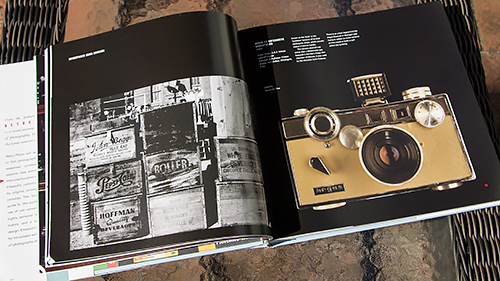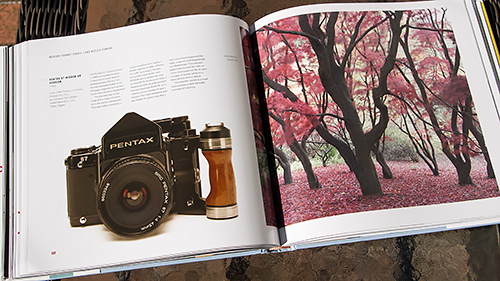Photo Corners headlinesarchivemikepasini.com
![]()
A S C R A P B O O K O F S O L U T I O N S F O R T H E P H O T O G R A P H E R
![]()
Enhancing the enjoyment of taking pictures with news that matters, features that entertain and images that delight. Published frequently.
Book Bag: Retro Photo -- An Obsession




27 September 2016
David Ellwand's Retro Photo -- An Obsession is something of a retro publishing event itself. First published last year in England by Old Barn Books, it will be available in North America on Oct. 4 in an edition published by Candlewick Studio. From this trivia you'll understand Ellwand is British.

And you know the British. Obsessions come easily to them.
Ellwand's obsession is vintage cameras. But if that were the end of it, we wouldn't be drawing your attention to his book of showing his collection of nearly 100 of them. This obsession only starts with old cameras.
Like those vintage automobile enthusiasts who like to race their old iron, Ellwand actually uses his collection to make pictures. An old car may run on today's lead-free gasoline but finding film for an old camera is not as easy.
So Ellwand cuts photo paper and sheet film to size for the cameras whose film is no longer manufactured.
Paper? But won't that produce a negative image?

Argus. With sample photo on facing page.
Bravo, now you're getting into the spirit of this obsession. Yes, Ellwand develops the paper as a negative image. But then he scans the image (looks like an Epson 700/750 to us) and reverses it in Photoshop.
He unabashedly (for a Brit) enjoys the personality quirks of the vintage capture as far as it goes before indulging in the magic of modern digital photography. In fact, he devotes a whole chapter to the subject at the end of the book.
You have to love that.
The 212-page book is organized in five chapters: an Introduction, Frame 1: 35mm, Frame 2: Medium Format Roll Film, Frame 3: Large Format Sheet Film, Paper and Plates, and Frame 4: Reinventions. There's an index as well.

Pentax. The grip is essential, Ellwand adds.
There are two other things we like a lot about the tour of his collection.
First, the cameras are not pristine. One, in fact, is a wreck, salvaged only for the 620 film spindle it contained. Still, it gets as nice a spread as any of the other cameras, some of which are pristine.
If condition wasn't Ellward's criteria for collecting these cameras, what was? He doesn't say but the descriptions hint that the small engineering advancements of the time captivated him. Here's how he describes his Agfa Karat, "The Karat system allowed film to be transferred from one cassette to the other, bypassing the need for a film rewind mechanism." Then he notes, "You can identify these by the lack of rewind mechanism on top of the camera."

Fujifilm. The X-Pro1 made the team.
The other thing we liked a lot are his explanations of the various categories of camera, which are clear enough for someone new to photography to appreciate. And, frankly, even an old hand will appreciate seeing the distinctions between various roll film cameras, a range of view cameras and other camera types. Sure, you knew Sinar was prized but Ellwand tells you why.
These little asides are so straightforward, you might miss them. So we'll quote one here:
With a twin lens reflect camera, the top "viewing" lens and the bottom "taking" lens are coupled, so when you focus through the top lens, you are guaranteed that the bottom lens is in focus.
This is more important, culturally, than one might at first realize. But Ellwand is the author of several children's books and the job of cultural transference isn't lost on him. One day all these Rollies and film Leicas will be discovered on a closet shelf and the smartphone-toting survivors will wonder what they are.
Ellwand can tell them not only what they are but how to keep using them and even work them into their digital lives.
Retro Photo -- An Obsession by David Ellwand, published by Candlewick Studio, 212 pages, $45 (or $32.50 at amazon.com).